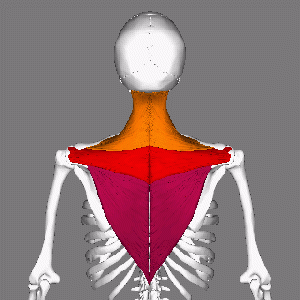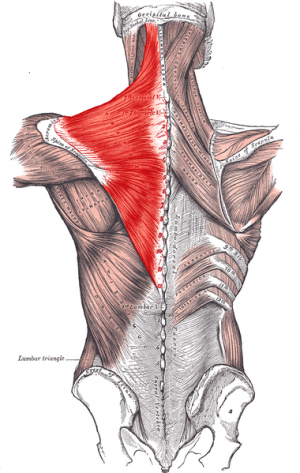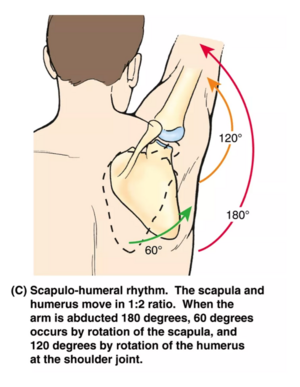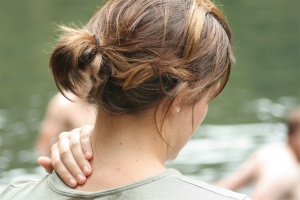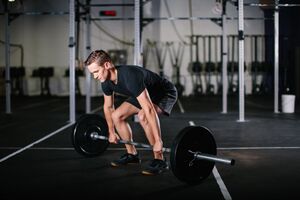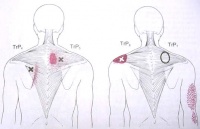Trapezius
Original Editor - Daphne Jackson
Lead Editors - Lucinda hampton, Andeela Hafeez, Kim Jackson, Kai A. Sigel, Daphne Jackson, WikiSysop, Joao Costa, Rachael Lowe, Evan Thomas, Tarina van der Stockt and Kirenga Bamurange Liliane
Introduction[edit | edit source]
The trapezius is a broad, flat, superficial muscle extending from the cervical to thoracic region on the posterior aspect of the neck and trunk. The human trapezius muscle has an origin that is more extensive than that of any other body muscle.[1]
The muscle is divided into three parts: descending (superior), ascending (inferior), and middle[2]. The muscle contributes to scapulohumeral rhythm through attachments on the clavicle and scapula, and to head balance through muscular control of the cervical spine.
In people who are chronically stressed or anxious the trapezius suffers. Hunching the shoulders and holding tension in the shoulders and neck, puts constant strain on the trapezius. Hence the trapezius is a major source of headache pain, usually a tension headache. [3]
Tearing or straining the trapezius is uncommon, usually only happening in bodybuilders lifting too heavy a weight. They also occurs in high velocity accidents eg motor vehicle accident.[4]
Origin[edit | edit source]
The muscle attaches to the medial third of superior nuchal line; external occipital protruberance, nuchal ligament, and spinous processes of C7 - T12 vertebrae[5].
Insertion[edit | edit source]
The muscle inserts on the lateral third of clavicle, acromion, and spine of scapula[5].
Nerve Supply[edit | edit source]
- Spinal root of accessory nerve (CN XI) (motor)[5]
- Cervical nerves (C3 and C4) (pain and proprioception)[5]
Blood Supply[edit | edit source]
Transverse cervical artery (cervicodorsal trunk)[5][2]
Function[edit | edit source]
The trapezius is a muscle made up of particularly long muscle fibers that spanning a large width of the upper back. Functionally, this enables the trapezius to assist in mainly postural attributes, allowing and supporting the spinal column to remain erect when the person is standing.[6]
Shoulder pain and dysfunction are among the most common orthopedic problems managed by physiotherapists, and the trapezius plays an important role in the shoulder.
- Appropriate kinematics of the scapula is crucial for optimal shoulder joint function, eg enabling repetitive movements of the hand over the head.
- Trapezius and Serratus anterior are the main muscles that optimize scapula position and scapulohumeral rhythm.
- If the scapula stabilizing muscles are weakened eg trapezius, the normal position and kinematics of the scapula become altered[7].
The trapezius muscle is also used for active movements eg side bending and turning the head, elevating and depressing the shoulders, and internally rotating the arm[6].
Action[edit | edit source]
- Descending part: elevates pectoral girdle[2]
- Middle part: retracts scapula[2]
- Ascending part: depresses shoulders[2]
- Descending and ascending together: rotates scapula upwards[2]
- Bilateral contraction: extends neck[8]
- Unilateral contraction:
Physiotherapy[edit | edit source]
Upper trapezius is frequently involved in neck injuries.
- The upper trapezius has a clear pain referral pattern to the head, so considered it when assessing for Cervicogenic headache.
- Postural issues eg Upper-Crossed Syndrome
Tearing or straining the trapezius is uncommon, usually only happening in bodybuilders lifting too heavy a weight. In high velocity accidents it also can be damaged, eg car crash.
Palpation: Trapezius muscle is superficial and all three portions can be palpated.
- Hold the sloping superior lateral portion between fingers and thumb and palpate from
origin, toward the clavicle/acromion, and its insertion. - With patient standing: abduct shoulders to 90 degrees and retract shoulder girdle.
- Slightly bend the trunk forward so antigravity. [9]
Upper Traps:
- Palpate upper trapezius in a weight bearing position (i.e. sitting / standing) and check for tension. Normally, this muscle should be relaxed at rest, so any tightness would indicate overuse of upper trapezius.eg forward head posture. Then position the patient in lying and compare the amount of upper trapezius tension. If the tension has resolved, there is likely to be a tone issue.[10]
- Alternatively, you can compare slumped sitting with an upright posture (i.e shoulders back). If the upper trapezius relaxes in the upright position, this again indicates a tone issue related to posture.
- Upper trapezius is frequently involved in neck injuries
Length Tension Testing
Patient: Positioned in supine lying with the arms resting by the side and the knees flexed.
Therapist: Standing at the head of the bed.
Action: The therapist supports the posterior aspect of the head with both hands and then passively flexes the craniovertebral joint. The right hand stabilizes the lateral one third of the patient’s right clavicle and acromion palpating the muscle. The therapist then gently and slowly flexes, left side flexes and right rotates the mid and lower cervical spine with the left hand. The hand stabilizing and the hand moving the body part senses the tension in the muscle. The amount of range and the end feel is assessed and the reproduction of any symptoms is noted. This test is then repeated on the contralateral side and compared. [11]
Treatment
Below are some treatment ideas.
1. Shoulder blade squeeze
2. Shrug
3. Upright row
4. Pushup
Stretching: Sit upright in a chair and make sure that your posture is correct. These stretches can be done in repetitions of 15-20 every hour to decrease trapezius muscle pain. Begin by rolling the shoulders back so that the shoulder blades feel like they are being pinched together. Then raise your shoulders up towards the ceiling and lower them down gently. You can then bend your neck from side to side by tilting your head towards your shoulder and counting to 3, then repeating in each direction.
Kinesiology Taping: Kinesiology Taping has an effect on kinematics, muscle activity and strength of the scapular region in people with shoulder impingement. A study found that taping over the lower trapezius muscle, resulted in positive changes in scapular motion and muscle performance. The results supported its use as a treatment aid in managing shoulder impingement problems.[12]
Massage: Pain in the shoulder and neck can be prevented or reduced with massage.It is possible to reduce trapezius muscle pain through self-massage. Reach back with one hand and find your trapezius muscle. Beginning at the base of the neck, try to knead the trapezius muscles.
Trigger Points: Myofascial trigger points (MTrPs) are considered the principal clinical feature of myofascial pain syndrome (MPS). An MTrP consists of spot tenderness within a taut band of muscle fibers and its stimulation can produce both local and referred pain.[13] There are six main trigger points of the trapezius, two in each portion of the muscle, plus one unusual one which causes only autonomic phenomena.[3]
See also Superior Scapula and Cervicogenic Headaches
Resources[edit | edit source]
This 2-minute video covers the trapezius.[14]
References[edit | edit source]
- ↑ Lindman R, Eriksson A, Thornell LE. Fiber type composition of the human male trapezius muscle: Enzyme‐histochemical characteristics. American Journal of anatomy. 1990 Nov;189(3):236-44.Available: https://pubmed.ncbi.nlm.nih.gov/2148051/(accessed 6.1.2022)
- ↑ 2.0 2.1 2.2 2.3 2.4 2.5 Moore KL, et al. Essential clinical anatomy. 4th ed. Baltimore, MD: Lippincott Williams and Wilkins, 2011.
- ↑ 3.0 3.1 Weebly The Trapezius Muscle Available: https://trapeziusmuscle.weebly.com/interesting-facts.html(accessed 6.1.2022)
- ↑ Health line 4 No-Weights Trapezius Exercises Available: https://www.healthline.com/health/no-weights-needed-4-trapezius-exercises(accessed 6.1.2022)
- ↑ 5.0 5.1 5.2 5.3 5.4 Department of Radiology, UW Medicine. Trapezius. www.rad.washington.edu/academics/academic-sections/msk/muscle-atlas/upper-body/trapezius (accessed 27 January 2014).
- ↑ 6.0 6.1 Ourieff J, Scheckel B, Agarwal A. Anatomy, Back, Trapezius. StatPearls [Internet]. 2020 Apr 17.Available: https://www.ncbi.nlm.nih.gov/books/NBK518994/(accessed 6.1.2022)
- ↑ Hwang M, Lee S, Lim C. Effects of the Proprioceptive Neuromuscular Facilitation Technique on Scapula Function in Office Workers with Scapula Dyskinesis. Medicina. 2021 Apr;57(4):332. Available:https://www.ncbi.nlm.nih.gov/pmc/articles/PMC8067054/ (accessed 6.1.2022)
- ↑ 8.0 8.1 8.2 Neumann DA. Kinesiology of the musculoskletal system: foundations for rehabilitation. 2nd ed. St. Louis, MO: Mosby Elsevier, 2010.
- ↑ https://www.fgc.edu/wp-content/uploads/2011/12/palpation-of-muscles.pdf
- ↑ Physiopedia Superior Scapula and Cervicogenic Headaches Availabe: Superior Scapula and Cervicogenic Headaches (accessed 7.1.2022)
- ↑ http://activepotentialrehab.com/docs/pdf/sample_upperextremity11_21.pdf
- ↑ Hsu YH, Chen WY, Lin HC, Wang WT, Shih YF. The effects of taping on scapular kinematics and muscle performance in baseball players with shoulder impingement syndrome. Journal of electromyography and kinesiology. 2009 Dec 1;19(6):1092-9. Available: https://www.sciencedirect.com/science/article/abs/pii/S1050641108001855(accessed 7.1.2022)
- ↑ Barbero M, Bertoli P, Cescon C, Macmillan F, Coutts F, Gatti R. Intra-rater reliability of an experienced physiotherapist in locating myofascial trigger points in upper trapezius muscle. Journal of Manual & Manipulative Therapy. 2012 Nov 1;20(4):171-7.Available: https://www.tandfonline.com/doi/abs/10.1179/2042618612Y.0000000010(accessed 7.1.2022)
- ↑ Trapezius muscle video - © Kenhub https://www.kenhub.com/en/library/anatomy/trapezius-muscle
